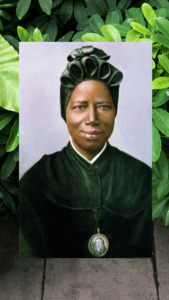St Josephine of Bakhita
St Josephine of Bakhita will wow you! Talk about a woman who suffered so much abuse and yet chose to love even the people who had mistreated her the most.
She said in one of her quotes…
“If I were to meet the slave-traders who kidnapped me and even those who tortured me, I would kneel and kiss their hands, for if that did not happen, I would not be a Christian and Religious today.”
Today, sit back, grab a cuppa and discover this amazing woman with me who is now a beautiful and inspring saint.

Who is St Josephine of Bakhita
St Josephine of Bakhita was a remarkable woman whose life story is both inspiring and heartbreaking. Born in Darfur, Sudan in the late 19th century, she was kidnapped and sold into slavery at a young age. She endured years of physical and emotional abuse at the hands of her captors before finally being freed and finding a new life in Italy.
Despite the trauma she suffered, St Josephine of Bakhita remained resilient and strong throughout her life. She was known for her kindness and compassion towards others, particularly children who had also been victims of slavery. She became a Catholic nun and devoted her life to serving others, using her own experiences to help heal the wounds of others.
St Josephine of Bakhita’s story is a powerful reminder of the resilience of the human spirit in the face of unimaginable hardship. Her life is a testament to the power of hope, faith, and love to overcome even the most difficult challenges.
Throughout her life, St Josephine of Bakhita never forgot where she came from. Despite the horrors she had endured, she remained proud of her African heritage and worked tirelessly to promote the rights and dignity of all people, regardless of race or background. (Catholic.org)
Today, St Josephine of Bakhita is recognized as a symbol of hope and resilience for people around the world. Her legacy lives on through the many organizations and initiatives that bear her name, and her story continues to inspire people of all ages and backgrounds.
As we remember St Josephine of Bakhita, we are reminded of the importance of standing up for what is right and fighting against injustice in all its forms. We are reminded that every human being, regardless of their background or circumstances, has inherent value and dignity that must be respected and protected.
May we all be inspired by St Josephine of Bakhita’s example to work towards a world where every person is free and valued, and where the darkness of slavery and oppression is replaced by the light of hope, freedom, and love.
What were some of the trials St Josephine of Bakita went through as a slave?
St Josephine of Bakhita’s life was marked by many trials and hardships when she was a slave. She was born in Sudan in the late 1860s and was kidnapped by slave traders at the age of seven. From that point on, she endured a life of brutality and servitude.
During her time as a slave, St Josephine of Bakhita was subjected to physical abuse and was forced to work long hours in difficult and often dangerous conditions. She was bought and sold multiple times, enduring the traumatic experience of being separated from her family and loved ones. (FransiscanMedia)
One of the most traumatic experiences of her life as a slave was the practice of tattooing. St Josephine of Bakhita was tattooed by her captors, a painful process that involved incisions made in her skin and salt rubbed into the wounds to ensure permanent scarring. These tattoos served as a form of identification for her captors, and they were a constant reminder of her status as a slave.
Despite the many trials and hardships she faced, St Josephine of Bakhita never lost her faith or her hope for a better life. Through her perseverance and her strong belief in God, she was able to find the strength and courage to escape from slavery and to begin a new life as a religious sister.
St Josephine of Bakhita’s life is a testament to the power of faith, hope, and resilience in the face of adversity. Despite the many trials and hardships she endured as a slave, she never lost sight of the hope and love that sustained her, and her example continues to inspire people around the world to this day.
How did St Josephine of Bakita become free?
The story of how St Josephine of Bakhita went to Rome with her slave owner is a significant moment in her life story. While in Rome, she was introduced to the Canossian Sisters, a group of Catholic nuns who would ultimately help her escape from slavery and begin a new life as a free woman.
St Josephine of Bakhita was brought to Rome by her slave owner, an Italian diplomat named Callisto Legnani. While in Rome, she was placed in the care of the Canossian Sisters, who were struck by her gentle and kind spirit despite the trauma and hardships she had endured as a slave.
As St Josephine of Bakhita spent time with the Canossian Sisters, she began to learn more about the Catholic faith and the message of God’s love and compassion. She became intrigued by the message of hope and freedom that the sisters shared, and her faith began to grow stronger.
One day, her slave owner attempted to take her back to Sudan, but she refused to go with him. With the help of the Canossian Sisters and a court case, St Josephine of Bakhita was able to secure her freedom and remain in Rome. She chose to stay with the Canossian Sisters and, in time, became a member of their religious order. (Vatican.va)
St Josephine of Bakhita ‘s story is one of courage, resilience, and faith. She was able to overcome the trauma and hardships of slavery through her unwavering belief in God and her determination to live a life of love and compassion. Her story continues to inspire people around the world to this day, reminding us of the power of hope and the resilience of the human spirit in the face of adversity.
Where is St Josephine of bakhita buried?
St Josephine of Bakhita, also known as “Mother Moretta,” was laid to rest in the small town of Schio in northern Italy, where she spent the last years of her life. Her burial place is located at the Institute of the Canossian Daughters of Charity, a religious order she joined in 1893 after being freed from slavery.
The Canossian Sisters, who continue to run the institute, have established a shrine in honor of St Josephine of Bakhita, where her remains are kept. The shrine, which is open to visitors, includes a small museum dedicated to her life and work, as well as a chapel where visitors can pray and reflect.
In addition to the shrine, there are several other places around the world where St Josephine of Bakhita is honored and remembered. For example, there are churches and chapels named after her in various parts of Africa and Europe, and her legacy is celebrated in many different ways by people of all backgrounds and faiths.
Despite her difficult and painful life, St Josephine of Bakhita’s legacy has continued to inspire people around the world. Her story is a reminder of the power of faith, hope, and love to overcome even the most difficult challenges, and her courage and resilience continue to serve as an example for people of all ages and backgrounds.



Want to take a pilgrimage to see St Josephine of Bakhita?
Well, if you’re looking to take a pilgrimage to see St. Josephine of Bakhita, there are a few things you might want to consider.
First and foremost, it’s important to do your research and find out where St. Josephine’s remains are currently located. As a former slave who became a beloved Catholic nun, St. Josephine has a number of sites associated with her around the world, including Italy, Sudan, and Kenya.
Once you’ve identified the site that you’re interested in visiting, you’ll want to start making your travel arrangements. Depending on your location and the site you’re visiting, this could involve a significant amount of planning and preparation, as well as potential language barriers and cultural differences to navigate.
Of course, the journey itself is just one part of the pilgrimage experience. When you arrive at your destination, you’ll want to take the time to reflect on St. Josephine’s life and legacy, and to seek out opportunities to deepen your faith and connection to her story.
This might involve attending Mass or other religious services, participating in prayer or meditation, or simply taking the time to explore the site and reflect on your own spiritual journey.
Ultimately, the pilgrimage to see St. Josephine of Bakhita is a deeply personal and meaningful experience, one that requires both careful planning and an open heart and mind. But for those who are drawn to her story and the example of her life, it can be a truly transformative journey.
The relics of St. Josephine Bakhita are located in a few different places around the world.
Her body is entombed in the chapel of the Canossian Sisters in Schio, Italy, where she lived and died. This chapel is open to the public for prayer and veneration.
In addition to her body, there are also some relics of St. Josephine located in Sudan and Kenya, where she was born and raised. In Sudan, there is a small museum dedicated to her life and legacy in the city of Khartoum, which contains some of her personal belongings and other artifacts. In Kenya, there is a shrine dedicated to her in the town of Nyeri, where she spent several years working as a Canossian sister.
If you’re interested in seeing her actual relics, then you need to go to Italy and visit the Chapel of the Canossian Sisters in Schio.
Schio is a 3 hour drive from Milan which is an affordable place to fly into Italy. Schio is also a 1 hour drive from Verona which has a cool walking tour and other beautiful things for you to do.
I’ve attached a fun day trip for you there. You can go exploring HERE or click on the picture below.

Feast of St Josephine of Bakhita
The feast of St Josephine of Bakhita is a special day for Catholics around the world to honor and celebrate the life of this remarkable woman. It is typically observed on February 8th, the anniversary of her death in 1947.
In many parts of the world, the feast of St Josephine of Bakhita is celebrated with Masses, prayers, and other special events. People gather to hear her story and to reflect on the lessons that can be learned from her life.
In some places, the feast day is marked with special traditions and customs. For example, in Sudan, where St Josephine of Bakhita was born, there may be special processions or ceremonies to honor her memory. People may also gather to share food and stories about her life.
In Italy, where St Josephine of Bakhita spent many years of her life, there are often special Masses and devotions held in her honor. Many people make pilgrimages to her shrine in Schio, where her relics are kept.
In other parts of the world, the feast day may be marked with acts of service or charity in St Josephine of Bakhita’s name. People may volunteer at local organizations that work to combat human trafficking and slavery, or donate to organizations that support victims of these crimes.
Overall, the feast of St Josephine of Bakhita is an opportunity for people around the world to come together and honor the life and legacy of a remarkable woman. It is a time to reflect on the importance of compassion, resilience, and the fight for justice, and to remember that even in the darkest of times, there is always hope for a better tomorrow.

St Josephine of Bakhita quote
St Josephine of Bakhita was a woman of great faith, courage, and wisdom. Her life story is a testament to the power of hope, resilience, and the human spirit. Here are a few of her most inspiring quotes:
- “Be good, love the Lord, pray for those who do not know Him. What a great grace it is to know God!”
- “If I were to meet the slave-traders who kidnapped me and even those who tortured me, I would kneel and kiss their hands, for if that did not happen, I would not be a Christian and Religious today.”
- “I am definitely loved and whatever happens to me, I am awaited by this Love. And so my life is good.”
- “I am a little pencil in the hand of a writing God who is sending a love letter to the world.”
- “The Lord has loved me so much: we must love everyone… we must be compassionate!”
- “The spirit of gratitude fills me, because I am certain in the Lord’s care.”
- “O Lord, if I could fly to my people and tell them of your goodness at the top of my voice, oh, how many souls would be won!”
- “All things pass; only God remains.”
- “I have come to love the darkness, for I believe now that it is a part, a very small part, of Jesus’ darkness and pain on earth.”
- “I wish to live a life of happiness and love, in the midst of the world’s troubles.”
Because I’m so inspired by the saints, I’ve put together a really cool shirt for you with one of my favorite quotes by St Josephine of Bakhita.
These shirts are awesome because they give you a simple way to start a conversation about the saints and share the story of St Josephine of Bakhita with your friends, family, or some random person you meet out and about. It also gives you an easy way to share the Gospel with them about how we are all sinners and fall short of the glory of God but that Christ died once and for all to save us from our sins.
You can even invite them to church and help them get enrolled in the RCIA classes at your Church.
I’m praying for you about this! Below is the shirt. Just click on it. Choose your favorite color and size and then click on the BUY NOW button to be taken to the check out page.

Prayer to St Josephine of bakhita
Here is a prayer to St Josephine of Bakhita:
“Dear St Josephine of Bakhita, you who were born into slavery but found freedom in Christ, we come to you in prayer today asking for your intercession. You know the pain and suffering of those who are still enslaved, and you know the power of God’s love to bring healing and hope.
We ask that you pray for all those who are still held in slavery and human trafficking, that they may find the strength and courage to escape their bondage and find the freedom they deserve. We pray for those who are working to combat this evil, that they may be strengthened in their efforts and encouraged by your example of love and compassion.
We also pray for all those who are suffering in any way, especially for those who are victims of violence, oppression, and discrimination. May they find comfort and healing in the love of God, and may they be lifted up by your prayers and intercession.
Finally, we ask that you pray for us, that we may be inspired by your example of faith, hope, and love, and that we may always seek to serve God and our brothers and sisters in need. Amen.”
St Josephine of Bakhita, pray for us!
What are some St Josephine Bakhita miracles?
There are a couple of particularly noteworthy miracles attributed to St. Josephine Bakhita.
The first occurred during her lifetime, when a young girl whom Bakhita was caring for fell seriously ill. Bakhita prayed over the girl and the child made a complete recovery. This was seen as a miraculous healing by those who knew the child’s condition.
The second miracle attributed to St. Josephine Bakhita occurred after her death in 1947. A young boy in Italy was suffering from a serious and potentially fatal illness. His family prayed to St. Josephine Bakhita for her intercession, and the boy made a complete recovery. This healing was seen as miraculous by the Catholic Church and was one of the factors that led to St. Josephine Bakhita’s canonization in 2000.
St Josephine of Bakhita Statue Icon
For many people, purchasing a St Josephine of Bakhita statue can be a way to honor and remember her life and legacy. The statue serves as a physical reminder of her story and can inspire people to reflect on her faith, courage, and resilience.
St Josephine of Bakhita’s life is a powerful testimony to the human spirit and the power of faith to overcome even the most difficult circumstances. She was born into slavery, but through her strong faith and perseverance, she was able to find freedom and a new life as a religious sister. Her story is an inspiration to people of all backgrounds, and her example of love and compassion continue to inspire people around the world.
Having a statue of St Josephine of Bakhita in one’s home, church, or place of worship can serve as a reminder to pray for those who are still enslaved and to work for justice and freedom for all people. It can also serve as a reminder to strive for a life of faith, hope, and love, even in the face of adversity.
In summary, purchasing a St Josephine of Bakhita statue can be a way to honor her memory and to keep her inspiring example close at hand, as a reminder to live a life of faith, compassion, and perseverance.
Are You Inspired?
Are you inspired by what you’ve learned today? I love sharing the lives of the saints. Check out our blog HERE for more inspiring saints! For example, you can learn about the early Christian martyrs like Saints Felicity and Perpetua or a more contemporary saint like Saint John of God.
Did you know that you can join us every day as we learn about the Saint of the Day? Take a minute to sign up for my daily saint emails that I’ll send you delivered straight to your email inbox. I know people are busy so I keep it short and sweet but also very educational so you can live your life with the saints as I do.
Also, I give you a free screen saver for your phone as an added gift. Just fill in your details and I’ll send you your new screensaver so you can download it right away. Enjoy!
Well, that’s all for today.
I’ll see you back tomorrow with another Saint of the Day to inspire you!
God bless you,
-Priscilla

